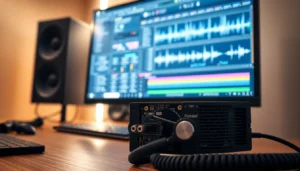Imagine diving into a world where sound wraps around you like a cozy blanket. That’s the magic of binaural audio. Unlike traditional stereo, which just plays sounds from left and right, binaural audio creates a three-dimensional sound experience that makes you feel like you’re right in the middle of the action. It’s like having your own personal concert or movie premiere right in your living room—without the overpriced popcorn.
Table of Contents
ToggleOverview of Binaural Audio
Binaural audio captures sound in a way that mimics human hearing. Specific recording techniques utilize two microphones positioned to replicate the human ear’s spatial arrangement. This method results in sound signals that provide a realistic perception of distance and direction.
Listeners experience an immersive soundscape, where sounds seem to originate from various locations around them. It differs markedly from stereo audio, where sound feels flat and less engaging. The use of binaural audio creates a three-dimensional auditory experience, enhancing engagement and presence in media.
Research indicates that binaural audio significantly impacts user experience in virtual reality and gaming. Various industries utilize this technology to enhance storytelling and emotional connection. For instance, filmmakers use it to place viewers in the scene, amplifying suspense or joy.
Many devices support binaural audio playback, including headphones optimized for high-fidelity sound. Formats like Dolby Atmos and ambisonics allow for intricate sound layering, appealing to audiophiles. Developers integrate binaural techniques into apps and platforms, offering users enhanced listening experiences.
As audio technology evolves, binaural audio remains integral in shaping future listening experiences. An increasing number of artists produce music specifically utilizing this technique, catering to modern listeners’ preferences. Binaural audio contributes significantly to the ongoing evolution of how sound interacts with the audience in immersive ways.
The Science Behind Binaural Audio

Binaural audio functions by simulating how humans perceive sounds in their environment. It captures sound through techniques that mirror human auditory perception.
How Binaural Recording Works
Binaural recording utilizes two microphones spaced to replicate ear placement. This method captures sound waves as they interact with the head, torso, and ears. Spatial cues like timing and intensity differentiate how each ear perceives sound. During playback, headphones recreate this experience, placing listeners in a three-dimensional audio environment. Sounds appear to emanate from various angles, enhancing realism. For instance, moving sound sources create an immersive feeling, as if they surround the listener. Many artists employ this technique in music and sound design, heightening emotional engagement.
Psychological Effects of Binaural Audio
Binaural audio significantly impacts listeners’ psychology. It elicits strong emotional responses by mimicking real-life sound interactions. Research shows this auditory immersion can reduce stress and anxiety. As listeners engage with the experience, they feel more connected to the content. The brain interprets audio cues to create a vivid mental image, enhancing storytelling effectiveness. For instance, gamers experience increased immersion, leading to deeper emotional investment in gameplay. Filmmakers harness this power to evoke suspense or joy, enhancing viewer engagement through sound.
Applications of Binaural Audio
Binaural audio finds applications across various fields, enhancing user experiences with its immersive soundscapes.
Virtual Reality Experiences
Virtual reality experiences utilize binaural audio to create authentic environments. By simulating realistic sound placement, users feel as if they are within the VR world. Developers integrate this technology into games and simulations, increasing the sense of presence. Sound cues guide users, enhancing navigation through virtual spaces effectively. Research shows that immersive audio can significantly improve user comfort and engagement in VR settings. Companies often employ binaural techniques to craft distinguishable sound elements that respond to user movements, making interactions within virtual environments more intuitive.
Music and Sound Design
Music and sound design also benefit from binaural audio applications. Artists leverage this technique to create immersive listening experiences that captivate audiences. Tracks produced with binaural recording can enhance emotional responses through spatial placement of sounds. Sound designers use binaural techniques for film scores, elevating scenes with precise audio positioning. Listeners appreciate the enveloping quality of binaural music, which often feels more engaging compared to traditional stereo formats. Festivals and concerts also adopt binaural sound to provide audiences with memorable auditory experiences that replicate the sensation of live performance.
Benefits of Binaural Audio
Binaural audio offers distinct advantages that enhance the overall listening experience. One significant benefit includes immersive soundscapes, which transport listeners into the action. Capturing audio in a way that reflects natural hearing creates a spatial awareness that stereo systems can’t replicate.
Listeners experience a more profound emotional connection with content. Whether it’s a film or a video game, binaural audio intensifies reactions, eliciting feelings of suspense or joy effectively. Enhanced emotional responses are linked to the brain’s interpretation of audio cues, fostering a richer engagement with the media.
The technology also provides a realistic representation of distance and direction. Sounds originate from varying locations around the listener, which enhances the perception of being present in the scene. This is particularly crucial in virtual reality environments, where sound directionality can guide user interactions.
Stress reduction is another noteworthy benefit of binaural audio. Many studies suggest that engaging with immersive sound can lower anxiety levels. Individuals report feeling more relaxed and focused when exposed to binaural recordings, making it a popular choice for therapeutic applications.
Additionally, binaural audio caters to various devices, ensuring compatibility across high-fidelity headphones and modern audio formats. Increased support for technologies like Dolby Atmos enhances the listening experience, allowing sound designers to craft intricate sound layers.
Artists and sound designers leverage binaural techniques for innovative music creation. Live performances increasingly utilize this format, providing concertgoers with an authentic auditory experience. As technology continues evolving, binaural audio remains a vital element in shaping contemporary listening preferences.
Challenges and Limitations
Binaural audio faces several challenges and limitations that impact its effectiveness. One obstacle arises with equipment compatibility. Many devices lack the capability to properly process binaural sound, limiting its potential audience.
Listener variability presents another challenge. Individual differences in hearing abilities and sensitivity to sound can affect the immersive experience. Some listeners may not perceive binaural audio as intended, diminishing its impact.
Additionally, environmental factors influence how binaural audio is experienced. Background noise can interfere with the clarity of spatial sound, detracting from immersion. Locations with high ambient sounds may result in a less effective listening experience.
Content creation also poses challenges. Producing quality binaural sound requires specific techniques and expertise. Not all artists or producers have the necessary skills, leading to inconsistent quality across recordings.
Furthermore, binaural audio often encounters limitations in distribution. Many streaming platforms do not support the technology, restricting access to the desired audience. Users must seek out platforms that provide binaural capabilities to experience its full benefits.
Finally, prolonged exposure to binaural audio can lead to listener fatigue. Some individuals may find the immersive sound overwhelming, preferring traditional audio formats. Balancing immersive experiences with comfort remains crucial in the continued adoption of binaural audio.
These challenges underscore the importance of understanding binaural audio’s context and applications. While the technology enhances user experiences, addressing its limitations can improve accessibility and enjoyment for a broader audience.
Binaural audio is revolutionizing the way listeners experience sound. Its ability to create immersive environments enhances emotional connections and transforms storytelling across various mediums. As technology advances, the potential for binaural audio continues to grow, promising even richer auditory experiences.
While challenges remain in terms of equipment compatibility and production quality, the benefits of binaural audio are undeniable. As more artists and developers embrace this technique, audiences can look forward to a future filled with captivating soundscapes that draw them deeper into their favorite content. The journey of binaural audio is just beginning, and its impact on entertainment and therapy is set to expand.



